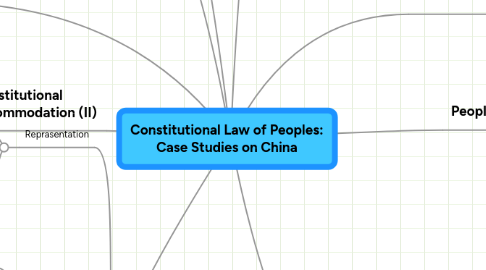
1. Constitutional accommodation (I)
1.1. Reprasentation
1.1.1. representation in the national people's congress
1.1.2. representation in the CPPCC
1.1.3. civil representation
1.2. Recognition
1.2.1. recognition to government
1.2.1.1. non recognition to Tibetan government in exile
1.2.1.2. one china policy and different interpretations
1.2.1.3. non recognition to Taiwanese authorities but to local governments in Taiwan
1.2.2. recognition to symbols
1.2.2.1. non recognition to snow lion flag
1.2.2.2. recognition to Hong Kong flag
1.2.2.3. non recognition to ROC flag
1.2.2.4. recognition to Chinese Taipei
1.2.3. recognition to political parties
1.2.4. recognition on international stage
1.3. Reciprocity
1.3.1. internal colonialism in Tibet?
1.3.1.1. internal colonialism theory
1.3.1.2. the prc government's aid plan
1.3.1.3. modernisation and its consequences
1.3.2. mainland-Hong Kong cooperation
1.3.3. cross-Strait reconciliation
2. Constitutional accommodation (II)
2.1. Legislative Autonomy
2.2. Executive Autonomy
2.3. Judicial Autonomy
3. Constitutional law of peoples
3.1. John Rawls' theory of 'law of peoples'
3.1.1. international law application
3.1.2. non central government
3.1.3. liberal hypothesis with more flexibility
3.2. China's particularity and peculiarity
3.2.1. to map all
3.2.2. in-between a central government and a foreign government
3.2.3. normative ideal with realistic flexibility
4. People within Peoples
5. Prospect
6. Introduction
6.1. Why it is a constitutional study?
6.1.1. international legal studies in the past
6.1.2. constitutional legal studies on prc in both china and the west
6.1.2.1. past imaginations
6.1.2.1.1. china as an empire
6.1.2.1.2. china as a communist regime
6.1.2.2. contemporary development
6.1.2.2.1. china has a constitution
6.1.2.2.2. cases have constitutional aspiration
6.1.2.2.3. the prc has turned more tolerable and tried to utilise constitutional accommodation already
6.2. Why three cases?
6.2.1. no comparative studies on three cases
6.2.2. to conceptualise a comprehensive map
6.3. What is the methodology?
6.3.1. a doctrinal research
6.3.1.1. this is a battleground, hardly neutral
6.3.1.2. there is even no comprehensive doctrinal research yet
6.3.2. informing normative misgivings
